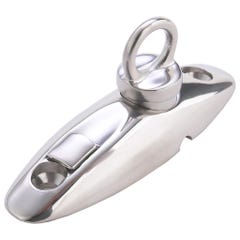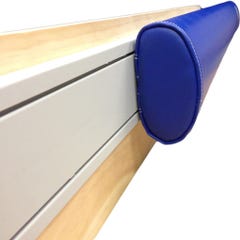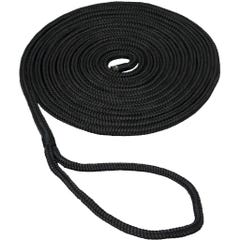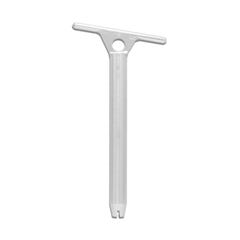Docking in Wind or Current: Six Rules to Remember
April 27, 2022 6 Min read


Docking a boat in wind and/or current doesn’t have to be hard. Just come alongside the dock and push the little joystick in the direction you want the boat to move, right? But for those of us who don’t have the luxury of one of today’s incredible multi-engine outboard control systems — or of a bow thruster, or even the superior maneuverability of a twin-screw inboard boat — docking in less than ideal conditions is still a challenge.
Contents
Six Rules to Remember
That’s largely because there simply is no universal formula. Between wind, current, dock and boat there are just too many variables to allow for step-by-step instructions. Even taking the wind, current and dock configuration out of it for the moment, every boat behaves differently.
Current, for example, exerts more force on deeper draft boats than shallower draft boats. Higher profile boats are more affected by wind than lower profile boats. Some boats — usually light hulls with higher bows — quickly swing stern-to-the-wind, while others drift naturally across the wind. Even propeller selection affects how a boat responds to throttle and steering inputs in tight quarters.
Even though there isn’t a one-size-fits-all procedure to learn, there are a few fairly simple rules and concepts that govern tight-quarters maneuvering in wind and/or current. Learn those, and you can then use them to adapt to each unique situation.
1. Keep the boat in gear for maximum control
Outboards and I/Os don’t steer very well when they’re out of gear. This sounds obvious, but it’s easy to forget under pressure, and it happens all the time — a skipper approaches the dock moving a little too fast, pulls the throttle back to neutral to “coast” the rest of the way in, but keeps right on working the steering wheel.
Will the boat steer? Sure, as long as it’s moving forward, but not nearly as well as it does in gear. The lower unit of the outboard or I/O still acts as a rudder, but without thrust from the prop, the steering effect on the boat is much smaller — and diminishes gradually to zero as the boat coasts to a stop.
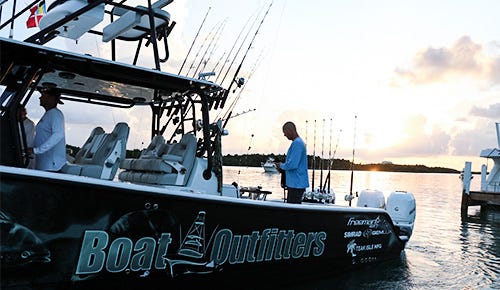



The lesson here is simple: don’t approach the dock quickly and then pull back to neutral a few yards out to slow down. Instead, get slowed down first and then approach the dock in gear at dead idle so you’ll have maximum boat control at all times.
Yes, there are docking situations that require more power than idle, but they’re infrequent. There are also situations that call for drifting or coasting, but the better you get, the less time you’ll spend in neutral. Practice using minimum throttle and keeping the boat in gear as much as possible when docking.
2. Given a choice, always dock into the wind and/or current
If the wind and/or current are moving parallel to the dock and you’re able to approach with your bow into them, they can actually make docking easier by giving you more directional control at a slower speed.
Think about a 3 knot current running parallel to the dock, for example. With a bit of forward throttle, you can hold your boat stationary in relation to the dock and yet still remain in gear with full steering control. That means you can simply “walk” your boat sideways in the current toward the dock with small steering inputs.
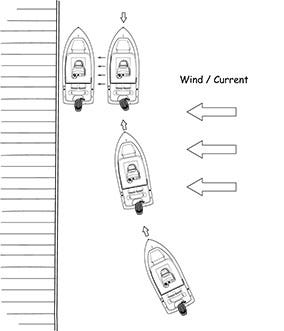

The problem with docking with (instead of into) the wind and/or current is that you have to be moving to have steering control. In forward gear, that means you’re moving at least the speed the wind/current is pushing you plus the speed the engine is pushing you. And with much wind or current at all, that’s faster than you want to contact a dock.
The solution is to dock in reverse. If, for example, you’re approaching a dock extending out from a leeward shore with a strong wind at your back, keep your stern into the wind and use intermittent reverse power to control your boat. Let the wind push your boat toward the dock, but use reverse power and steering to slow your drift as needed and “walk” your boat across the wind.
When the situation allows, you can also back up against the wind/current. If you’re approaching a dock running parallel to the shore of a river or tidal channel, for example, try going slightly downwind or downcurrent of the dock and then approaching in reverse. Since boats steer more from the back than the front (see below), it’s actually surprisingly intuitive to maneuver in reverse against the wind or current.
3. Given a choice, always dock on your port side.
Right-hand rotation propellers — those that turn clockwise in forward — pull the stern of the boat laterally to port in reverse and to starboard in forward. This effect, known as prop walk, is most pronounced at slow speeds. At higher speeds, the increased water flow over the lower unit minimizes the tendency to “walk” sideways. (Note that multi-engine boats are almost always set up with counter-rotating props to negate prop walk, so this rule really only applies to single outboards and I/Os.)
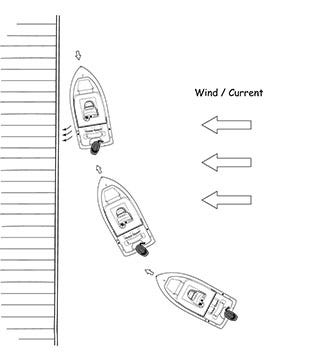

As you idle up to a dock on your port side and shift into reverse to check your forward motion, the prop will naturally walk your stern toward the dock. In most situations, you’ll also have to turn the helm to port while shifting to reverse, but at least with the dock on your port side, prop walk is working for you rather than against you.
In calm conditions, with a little practice, you can actually use prop walk to pull your stern to the dock without even turning the wheel. As you approach at a shallow angle in forward idle with the dock to port, shift into reverse and apply some throttle. The boat will slow and stop while also moving laterally to port.
4. Steer it like a forklift, not like a car.
It’s easy to make the assumption — especially when things are happening fast and you’re acting reflexively — that boats steer like cars. But that’s not the case at all. Instead, they steer more like forklifts, which have the steering tires in the back.
When a car turns, assuming no slippage, the front tires follow an arc with the rear tires following a slightly smaller arc inside the path of the front tires. On a boat, though, it’s the bow that follows the smaller arc, with the stern making a wider arc behind it and the whole thing sliding sideways. One way to understand the behavior of a boat making a hard-over turn at idle speed is to visualize a car that’s “drifting” around a sharp curve. The car’s front wheels stay closer to the inside of the turn and slide less, while its rear wheels slide through a larger arc and the whole car slides somewhat laterally.
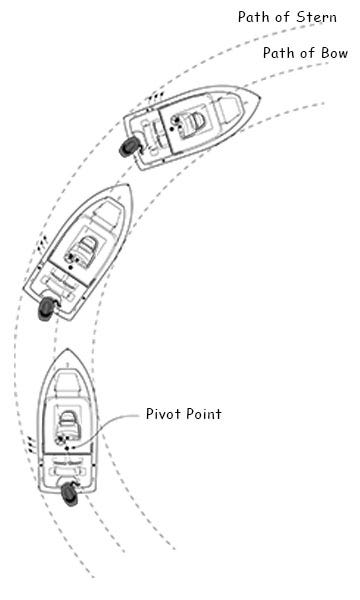

When it comes to docking, keep in mind that you’re steering your boat’s stern more than its bow. On most recreational outboard and I/O boats, the pivot point is around a third of the way back from the bow. In other words, if you’re idling forward in a straight line and turn your helm hard over to starboard, the first and biggest effect is that your stern will shift to port. Then your bow will start moving to starboard, with the boat “rotating” around a spot closer to the bow than the stern.
All of this is most important when you’re leaving a dock, especially one that the current and/or wind is pushing you against. If you try to simply turn the helm away from the dock and shift into forward — like you would when pulling away from a curb in your car — you’re just going to push your stern into the dock.
In calm conditions with a boat under 30 feet or so, all it takes is a good shove away from the dock to give you the clearance you need to pull away in forward. With wind and/or current pushing your boat against the dock, try leaving the dock in reverse. Turn your helm hard away from the dock and have a crew member shove your stern away from the dock as hard as safely possible. Then immediately shift to reverse idle and back well clear of the dock.
In extreme wind and/or current, or with a boat that’s too big to shove around by hand, you can use docklines to get clear of a dock you’re being pushed against. Tie a line from a bow cleat to a point on the dock closer to midships, using fenders to protect the hull side. Then turn the helm hard over toward the dock and shift to forward idle. The engine thrust will push the stern away from the dock, while the line holds to bow against it. Then release the line, shift to reverse and back away.
5. The upwind/current side of the dock is easier but not always better.
With a wind/current moving perpendicular to a dock — at a boat launch on the shore of a river, for example — there’s a side of the dock that conditions want to push your boat against and a side of dock that conditions want to push it away from. For simplicity, let’s just use the terms upwind and downwind.
The upwind side of the dock is generally the easiest side to dock on. That’s because you can stop the boat a few feet from the dock and simply let the wind or current push you the rest of the way in.
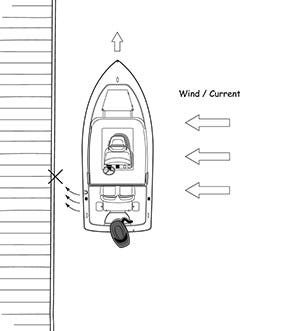

There’s lots of room for error. The drawback to docking on the upwind side is that once you’re docked, conditions will keep pushing your boat against the dock. Depending on the severity of the conditions, and the construction of the dock, this can potentially damage your boat and can also make it difficult to leave the dock.
Docking on the downwind side, on the other hand, means the wind/current holds the boat off the dock and also makes it easier to leave the dock. But approaching from the downwind side is more challenging than from the upwind side. Generally speaking, you’ll want to approach the dock at a sharper angle, turn along the dock as late as possible and be prepared to use more reverse power than normally required. Steering and throttle inputs will need to be crisper and more precise overall. As soon as the boat comes alongside the dock, the wind/current will start pushing it away again, so crew should be ready to step quickly to the dock with lines.
6. Take it slow, smooth and deliberate.
Perhaps the most important thing to master for any tight-quarters maneuvering situation is to keep a cool head. At the end of the day, it’s almost as much a mental challenge as a matter of skill. If you lose your cool and start acting reflexively, bad things happen.
Try to do everything at idle speed, make smooth transitions between gears and directions and minimize time spent in neutral, when the wind and current are more in control of your boat than you are. And always keep in mind, there’s no shame in aborting an approach. Better to back off, reset and try again than risk damage or injury.

